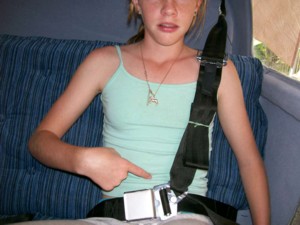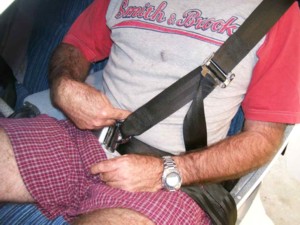Seatbelts and Some Other Safety Issues
Something you have to bear in mind is that both practically and legally the aircraft you produce from parts supplied by Jabiru aircraft company is, when completed, not just a “Jabiru”.
It is a “Insert your name here Jabiru”
YOU are responsible for the safe production of the aircraft NOT Jabiru. Under Australian law (don't know about any other countries) if you produce the aircraft and it is not safe then you are responsible for the consequences not Jabiru. So if you believe something in your kit, as supplied by Jabiru, is not safe then it is up to you to actually redesign and fix the problem. Don’t just say, “ Jabiru have been making them for ages and no one has complained about this, so it must be all right." Do some research and find out if there is a problem.
You may have found something that no one else has thought of or been the first to have had a situation arise which exposes a problem.
Which leads me to TWO safety risks which are an integral part of the Jabiru (at least were in my kit - perhaps they have been corrected now) and which I believe should be corrected.
1. Seat belts
Seat belts
2. Rear passenger door
Rear passenger door
Seat belts:
I have now flown in three Jabiru J400 series and all have the same problem. Mine were supplied in the kit as “AmSafe” brand belts. Each consist of three parts. A sash belt and a two part lap belt. The problem is that the inside half of the lap belt is quite long and is a fixed length. When the lap belt is buckled up the attachment point for the sash belt is roughly in the midline of the body or in the case of a child closer to the outer side of the body. This means the sash only supports the outer half or less of the upper body.
In the event of an impact the wearer will suffer “Dynamic Rollout”. That is the upper half of the body will move forward to the sash, then roll around the firmed up strap and forward and out of the strap allowing the head to contact the dash.
I researched this topic, spoke to an Australian aviation seatbelt manufacturer and conducted rudimentary tests on my airframe and this phenomenon does happen. As I result I sent off my belts to the certified aviation harness manufacturer and got them shortened. For sash belts to work correctly the sash component should cross the whole upper body from one hip to the opposite shoulder.
A note: Don’t just turn the belt around so the adjustable half is on the inside. If you do the sash and adjustable lapbelt half remains joined across the body when you undo the buckle. This means releasing the belt becomes a two part procedure. Obviously this means a wearer is more likely to become trapped by the belt.
How can this situation arise:
You might ask – If this is a problem how can Jabiru supply belts that are unsafe?
In practical terms I can only guess that it has escaped attention. In legislational terms, the belts, as supplied, actually comply with Australian Aviation Standards. This is because the Australian standards actually don’t address the issue of where on the body the sash must sit. The Australian Standards on use of lap-sash belts just state the belts must comply with the British and American standards. When you follow the threads the standards refer to levels of force the belt material can withstand, materials they can be made from etc. These standards also refer the reader onwards to other standards until the trail actually dissolves without mentioning the position of the sash!
The only mention of sash belt location is to be found in the Australian Automotive Standards and this might surprise you but these belts as they were supplied to me would not be legal to install in a motor vehicle in their standard configuration. If the half belt is shortened such that the buckle is closer to the hipbone and the sash crosses the whole torso they would be fine. Otherwise, in terms of materials, buckle structure etc the belts are fine.
I have no links with, nor receive anything from the people I dealt with, but I can recommend “Australian Aviation Harnesses and Seatbelts” in Townsville, Queensland, Australia. They gave me advice, directed me to legislation that did exist and shortened mine, issued release certificates and were very quick.
The Rear Passenger Door
When the flaps are in the full down or take-off position the rear door can not be opened! This presents the scenario that in a crash on take off or landing or ditching in water, if the electrical system is damaged and/or the pilot is not able to raise the flaps the back passengers will have no means of escaping. With two adults in the front and the aileron cables where they are the rear seat passengers will no means of getting out through the front doors either.
As yet I have not heard of it being a problem in Jabirus but it was a real problem in Cessna 206s. A few years back there were a spate of float-mounted 206s overturning on lakes in Canada and rear passengers drowning. It took some time to work out that they were entrapped by the flaps being in the down position.
I spoke with Jabiru about this and did they have an answer? Their answer was that the J 400 series is adapted from their certified J200 series which does not have back seats just baggage. So in their aircraft there is no problem.
At present I am working on a removable handle based set of hinge pins so the whole door can be jettisoned from inside. I haven’t actually got a working prototype at present but will keep the web site updated as I progress.
In the mean time, when I have had a passenger in the back I have briefed them that in the event of problem the door is fairly light in construction and they should force the door open expecting the flap to offer resistance. The door will hopefully break. It isn't a good answer, especially if the person were injured.



